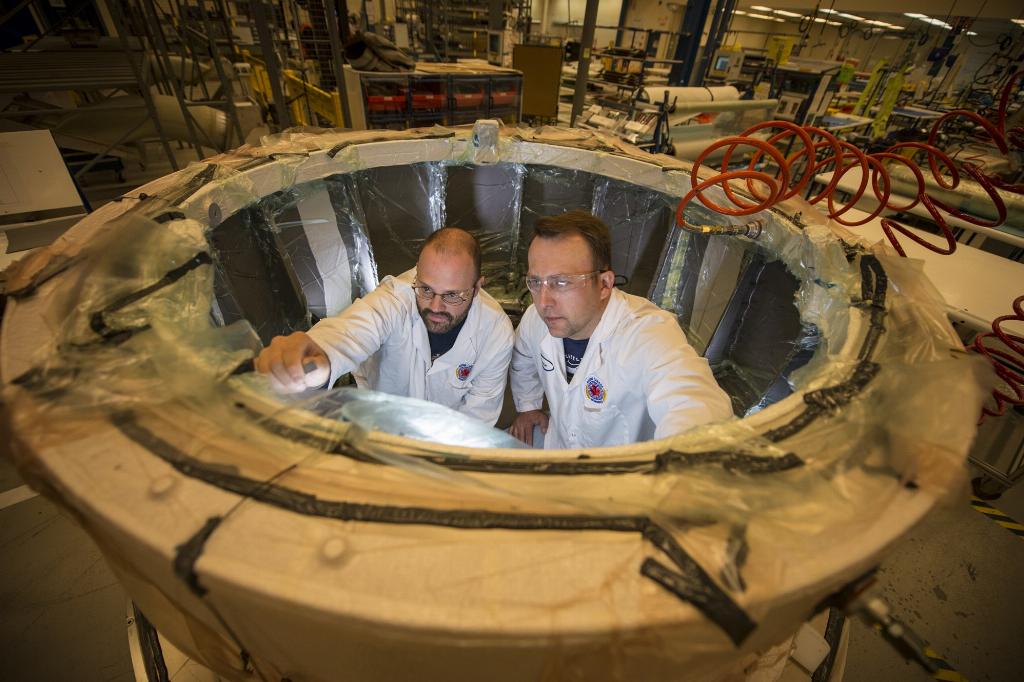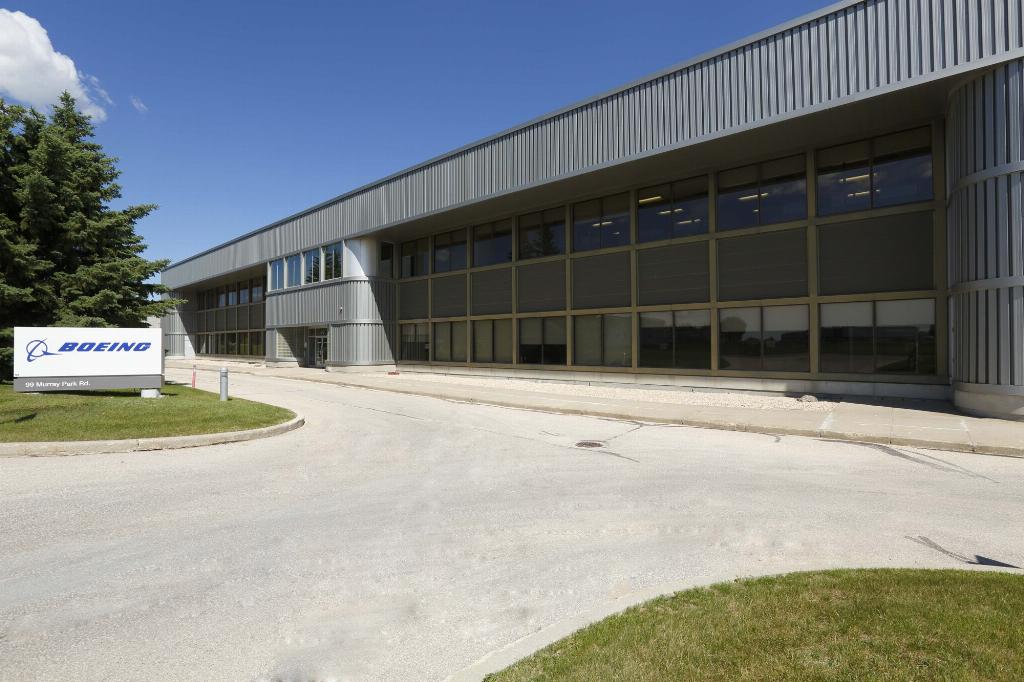A place where composites are king

With nearly 1,600 people making components for Boeing Commercial Airplanes, Boeing Canada is the largest composite manufacturing centre in the country. James Careless reports.
Composite parts and assemblies are a major part of today’s Boeing commercial aircraft. Major 737 MAX components such as wing-to-body and engine strut forward/aft fairings, landing gear doors, and engine inlet barrels are all made of composite materials – and all are being manufactured in Winnipeg, Manitoba.
Winnipeg is home to two Boeing Canada manufacturing facilities. Opened in 1971 with just 57 employees, today’s Boeing plant employs nearly 1,600 employees and has 800,000ft2 of production space in total.
This is where Boeing Canada’s advanced production facilities manufactures 560 composite parts for all of the company’s current 7 Series jetliners. (In fact, Boeing Canada is a tier one supplier to the 787.) The plant’s many production lines are divided between cleanrooms, where the composites are handled prior to be cured using auto-claves, and non-clean production rooms after the composites have been cured.
“We are Boeing’s Centre of Excellence for hand lay-up fabrication of sandwiched complex structures,” begins Kim Westenskow, managing director of Boeing Canada Operations and general manager of Boeing Canada in Winnipeg. “Almost everything we build is a composite panel. But instead of having ribs for strength, we use honeycombed cores as our structure.”
Westenskow was in this position when this article was researched. She has since been promoted to become a vice-president with Boeing Defence, Space & Security in the US. Amy May is the new general manager for Boeing Canada Winnipeg as of January 2019.
Boeing Canada has been working in composites since its Winnipeg plant opened 47 years ago.
“Back then we started out making less complex composite parts, and actually built bathtub enclosures,” Westenskow explains. This isn’t as unconventional a path to aerospace composite manufacturing as it may seem.
“The fibreglass techniques necessary to build a bathtub enclosure are very similar to what we do to when we layup panels.”
Among the largest composite parts built by Boeing Winnipeg are the 787's main landing gear doors. Each one measures 14' by 16' (4.3m by 4.9m) and comprises two composite face shields sandwiched to a complex 4" thick honeycombed core to give it strength, flexibility, and lightness. Using this approach allows Boeing Canada to reduce the amount of filler and structural supports in the landing gear door panels, which helps keep the weight down. However, it is not a one-step process.
“This composite core is built up and cured in the autoclave first, before we apply the two face sheets.”
To make the main landing gear door panels, Boeing Canada technicians start by laying out and then cutting resin-infused composite cloth.
“We do this just as you would if you were a suit manufacturer, cutting up the pieces of cloth to make up the panels.”
At the same time, the 787 landing gear door cores are put together using several different densities of core material. These are cut into complex shapes and sealed together to make a single structural piece, then cured. Once this is done, the core and the composite cloth pieces are brought together and cured into a single entity.
“We then trim the landing gear door, drill holes for the hardware attachments, paint it, and then add the hardware; all in our Winnipeg plant. After that, the panel is quality-checked using non-destructive testing, and sent to Boeing’s factories in Seattle or South Carolina.

Maximising quality and consistency
Despite the modernity of Winnipeg’s composite aerospace products, much of the work in this plant is still being done by hand. This is why the factory adheres to the ‘Boeing Production System’, which aims to maximise product quality and consistency through the standardisation of manual techniques and production procedures.
“We call this approach ‘Standard Work’,” states Westenskow.
To consistently achieve Standard Work quality, Boeing Canada has its people follow standardised production procedures; resisting the human tendency to tinker with the process. At the same time, the company is always seeking ways to improve production, but only through its employees using systematic problem-solving to devise and advocate for process improvements.
In this way, “we continue to see better performance,” says Westenskow. “Most of our employees - the people who come up with these ideas - are on company improvement teams.”
One specific way that Boeing Canada employees are improving the company’s production process is by reducing the usage of autoclaves in composite parts manufacturing.
“For instance, our people have helped us cut the autoclave curing requirements for the 737 MAX acoustic barrel from three cycles to two by re-engineering the part; cutting the requirement by one-third.”
Boeing Canada is also working on lightening the low-density cores within its composite parts, to reduce aircraft weight and fuel usage.
“We want them to be as strong as the airplane needs them to be, but not so strong that it adds to the weight.”

The benefits of expansion
In the past four years Boeing Winnipeg has added 150,000ft2 to its production space, to make room for manufacturing the 737 MAX’s acoustic inner barrel (part of the engine nacelle) and other composite parts.
“This allowed us to bring a lot of automation into our factory, and improve our production systems. We were able to make a much safer working environment, including adding robots to drill hundreds of thousands of perforations in the inner barrel to help reduce engine noise.”
Within this new space, Boeing Winnipeg has been able to automate its drilling countersink machines, to eliminate the need for operators to do the drilling directly. Meanwhile, its lay-up tools are now being cleaned using automated laser ablation, to remove resin residues that build up over time.
“We used to do this using a jitterbug hand sander. Now we clean our tools using a robot with a laser, meaning that people no longer have to do this job.”
Painting has also been automated, with composite parts rolling down a production line and being painted without any direct human intervention.
“Having this new facility has generally allowed us to make many positive changes using automation. We have been able to improve productivity, quality, and worker safety; all at the same time.”
With air traffic growing worldwide, and airlines moving to modern aircraft that include substantial composite content, the future is looking bright for Boeing Canada and its employees in Winnipeg.
“Our job is to meet rising aircraft production rates; pushing costs down while keeping quality and safety up,” concludes Westenskow. “This is why we are adding more automation at Boeing Canada, but doing so with the direct input of our workers. After all, they are transitioning from hand operations to running automated production systems on our behalf. We’re not adding automation to cut jobs, but to better achieve Standard Work.”










